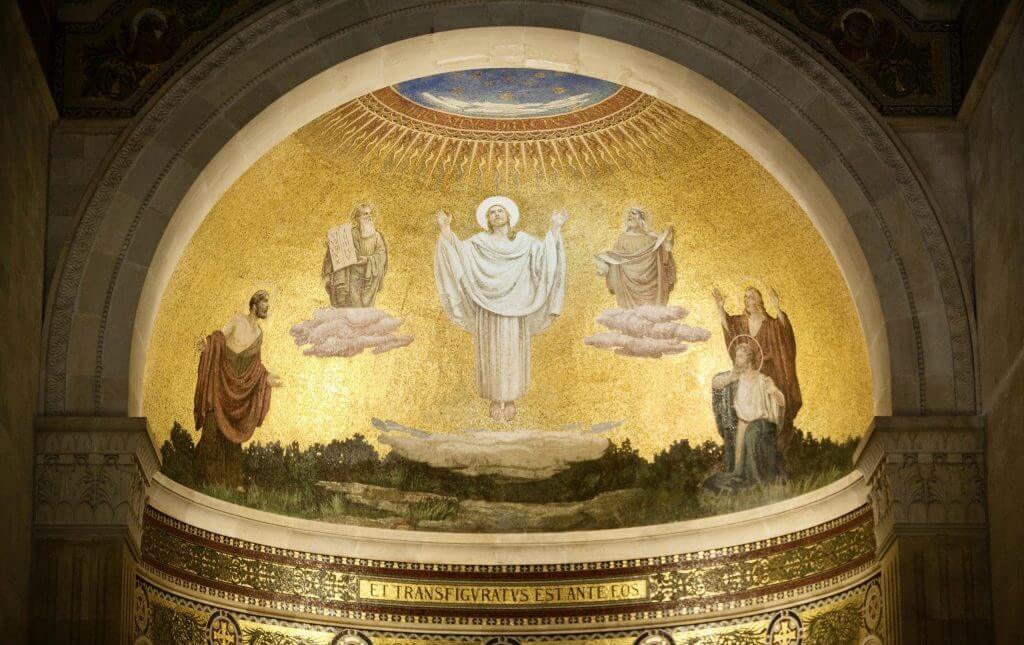Today, the Church celebrates the Feast of the Transfiguration.
The Feast of the Transfiguration is one of my favorite feast days. Why? I’m not exactly sure. Perhaps it’s because I love being on top of high mountains, where I experience a sense of majesty and peace and the grandeur and power of God—and where the views are amazing!
Maybe it’s also because of the hope this feast brings us. The Byzantine Vesper hymns for the Transfiguration tell us that Jesus was transfigured on the mountain to show His apostles “the glory of [His] divinity, so that “when they would see [Him] crucified” they would not despair, but would know “that [He] suffered willingly” and would remain hopeful for the resurrection.
The voice of the Father bore witness to Him in the cloud, and the disciples saw Him speaking with Moses and Elijah, as the One who came to fulfill both the Law and the Prophets. It was evidently such a wonderful experience that they didn’t want to leave—as Peter expressed, “Lord it is good for us to be here.”
However, this is also one of the feasts that may seem hard to relate to.
What kind of lessons can we take from it for our daily lives? While it may seem like a rather ethereal mountaintop moment, the implications for our lives are enormous.
First of all, as St. John Paul II exhorts us:
“Like Peter, James and John, we too are invited to climb Mount Tabor with Jesus and to let ourselves be awed by the splendor of his glory.”
- John Paul II, Visit to St. Mary Star of the Sea Parish in Castel Fusano, Rome, February 28, 1999
What is amazing is that Jesus was also showing us the glory for which we too are destined—the glory we were made for. Created in God’s image, we’re made to be “partakers of the divine nature” (2 Peter 1:4). Do we contemplate this reality enough?
In beholding Christ’s transfiguration on the mountain and hearing the Father’s voice saying “This is my beloved Son, with whom I am well pleased; listen to Him” we are seeing exactly who we were created to be: God’s beloved sons and daughters by adoption, radiant with the glory of the resurrection. (cf. Mt 17:1-8, Mk 9:2-8, Lk 9:28-36)
John Paul II reminds us:
“Listening to Jesus means following and imitating him. The cross has a very special place on this journey. There is a direct connection between the cross and our transfiguration. Imitating Christ in death is the way that leads to the resurrection of the dead, that is, to our transformation in him (Phil 3:10–11).”
- John Paul II, Beatification of the Servants of God José Aparicio Sanz and 232 Companions, March 11, 2001
Perhaps this is still too lofty a concept to digest.
Well, let’s also consider that one of the reasons Jesus revealed His glory to Peter, James and John is because they would be with Him in His agony in the garden, as His Passion was beginning. They would see Him mocked, beaten and crucified. He wanted them to have hope—to know that He was freely surrendering Himself for our sake, and that as God, He would rise again.
He also wanted to give us hope for those challenging moments in our lives—our own personal valleys of darkness and moments of crucifixion—those moments when we feel like we lack the strength to go on. Our hope consists in the fact that this life is not all there is, that we’re destined for heaven, if we choose that path. But the only path to heaven is the Cross. Keeping our focus on our goal is what can keep us walking that path with Christ, even when the road is rocky and painful.
Dr. Tim Gray reflects:
“Perhaps this recollection of Jesus’ splendor is what strengthened Peter and James as they were awaiting martyrdom. Or maybe the remembrance of Jesus glorified was what helped John get through many lonely years of exile. The glorification of the humanity of Christ gave them a momentary glimpse of what God had in store for them after their own death: resurrection from the dead and the glorification of their own humanity. As Saint Paul writes: ‘So we do not lose heart. Though our outer nature is wasting away, our inner nature is being renewed every day. For this slight momentary affliction is preparing for us an eternal weight of glory beyond all comparison’ (2 Cor. 4:16–17).”
- The Luminous Mysteries: Biblical Reflections on the Life of Christ, p. 97
We must keep our eyes fixed on our goal.
In those moments of darkness—whether it be with sickness, the pandemic, political and societal unrest, problems with work, turmoil in our families, the loss of loved ones, uncertainty about one’s vocation or path in life—the key point is to keep our eyes fixed on Jesus. We can’t do it without Him or without the help of the Holy Spirit, the Comforter, the One who helps us live the virtues of wisdom, courage and hope.
Knowing our goal—union with God in heaven, in a love which surpasses all that we can imagine—helps us choose our daily path. Knowing that we’re made to be transfigured—in the final resurrection yes, but also moment by moment during our earthly journey—gives us a purpose and a confidence in knowing that our daily crosses are bearing eternal fruit.
Whether we’re currently on a mountaintop or in a valley, let us continue our journey, encouraged by the words of St. John Paul II:
"What are “transfigured” men and women like? The answer is very beautiful: they are people who follow Christ in living and dying; who are inspired by him and let themselves be imbued with the grace that he gives us; whose food is to do the Father’s will; who let themselves be led by the Spirit; who prefer nothing to Christ’s kingdom; who love others to the point of shedding their blood for them; who are ready to give him their all without expecting anything in return; who—in a word—live loving and die forgiving. "
- John Paul II, Beatification of the Servants of God José Aparicio Sanz and 232 Companions, Sunday, 11 March 2001
Find Your Forever.
CatholicMatch is the largest and most trusted
Catholic dating site in the world.







